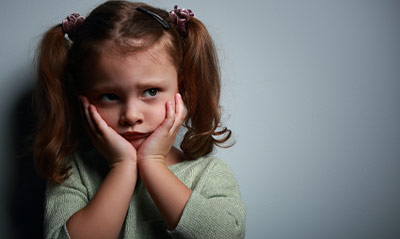Addressing Health Equity
Trauma Awareness
August 12, 2019 by David McKay Wilson
by David McKay Wilson
Childhood trauma is pervasive in American society—be it the loss of a parent, a serious
illness, exposure to violence, bullying or homelessness.
How children deal with that trauma—and how psychologists interact with clients and
other health professionals to address these issues—is the focus of work by two PCOM
alumni who say it’s a critical issue in today’s healthcare arena.
Kerri A. Flatau, PsyD ’18, a school psychologist at Garnet Valley School District in suburban Philadelphia,
and Stephen DiDonato, MS/CCHP ’12, PhD, LPC, NCC, assistant professor, community and trauma counseling, at Thomas Jefferson University,
say awareness of trauma in a client’s past can help inform treatment.
“Trauma occurs when our internal coping mechanisms become overwhelmed,” says Dr. DiDonato,
who also serves as co-director of the Jefferson Trauma Education Network. “Trauma
can occur from incidents such as physical abuse, or you can experience trauma from
daily environmental stressors. Your zip code can be more important than your genetic
code.”
A landmark 1998 study of 17,000 adults, which found that 50 percent had lived through
at least one “adverse childhood experience,” provides a foundation for work in trauma
care. The research found that trauma is a fact of life. Bad things happen to all people,
in all socioeconomic strata. Subsequent studies have shown a rise in the childhood
exposure to traumatic events that disrupt a child’s sense of safety and security,
with the prevalence of gun violence, increased urban poverty, and the growth threat
of cyberbullying. The exposure also increases risk for most common chronic diseases,
from heart disease and cancer to depression and substance abuse.
“You have families where both parents could be working two jobs, struggling with financial
resources, and it makes it much more difficult to help their kids because the parents
are so stressed out,” Dr. DiDonato says. “If I’m overstressed, how can I provide my
child with the kind of calm, regulated environment that can help them heal?”
“A bad day on Snapchat or Instagram for a teenager can become all-consuming for the
individual targeted by cruel postings that remain for all to view,” says Dr. Flatau.
“When I was in middle school, disputes were over that day,” she points out. “Now it
continues and continues on social media. People can get really nasty online, and the
person targeted can’t get away from it,” she says. “They get inundated with negativity,
and that can build up to something that becomes traumatic.”
The link between trauma and health
The issue is part of a wider discussion within healthcare circles about health equity:
how one’s socioeconomic status can lead to inequitable health outcomes regarding a
person’s longevity, quality of life and rates of disease. Dr. DiDonato notes that
“individuals who grow up in poverty, with stresses of food insecurity, housing insecurity
and the fear of violence, may have more difficulty dealing with trauma when it takes
place because they have fewer buffers when an incident occurs.”
Studies show that trauma can change brain function, which can make it more difficult
for stressed children to learn. Such adverse experiences may derail optimal physiological
development and result in detriments to mental health and to social problems.
Then there’s the generational trauma felt by groups such as African Americans, who
endured slavery, or Native Americans, who survived the trauma of genocide. Dr. DiDonato
cautions that historical stresses can get passed on from generation to generation.
“If you have no choice in your job or your kid’s education and no power or control
in healthcare decision making, such subjection can reinforce generational trauma,”
Dr. DiDonato says. “We in the healthcare world need to team up with those in the community
to provide more equitable and appropriate care.”
Opportunities for intervention
The impact of these incidents—whether generational, in conflicted relationships or
within a family—differs from individual to individual. Even within a family, siblings
can experience their parents’ divorce differently. What can be experienced as a trauma
for one sibling may not be for another, depending on their own personalities and the
support systems around them.
“Divorce can be different for siblings,” says Dr. Flatau. “There can be less impact
on a sibling with social supports, compared to their brother or sister who is introverted.”
Children who are exposed to trauma can react in various ways—from social withdrawal
and aggressive behaviors to self-medication through substance abuse and expressions
of hopelessness.
Dr. Flatau’s doctoral thesis in 2018 led to development of a 21-page training manual
for school psychologists that she’s using in the Garnet Valley schools to raise awareness
among teachers and school staff about student response to trauma and the interventions
that can ameliorate its impact. Positive relationships in the school setting can increase
a student’s feeling of safety and trust. She warns that such relationships can take
weeks, or even months.
Dr. Flatau has used the manual in an eight-hour training for school staff, conducted
over four sessions. It includes strategies for teaching the core elements of resilience,
helping students adapt to adversity and stress in their lives. Strategies also include
teaching students ways to calm themselves in periods of stress, that they have power
over their decisions, and that cultivating relationships with friends and teachers
can help them thrive.
She contends that resilience can be learned, taught, modeled, practiced and reinforced.
Promoting safe, stable relationships opens doors to connections that can reduce or
mitigate adversity.
READ THE FULL ISSUE OF DIGEST

 by David McKay Wilson
by David McKay Wilson